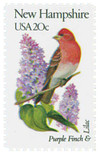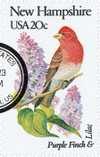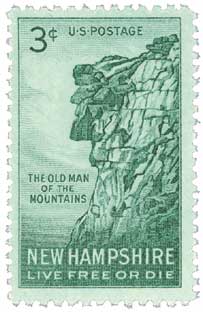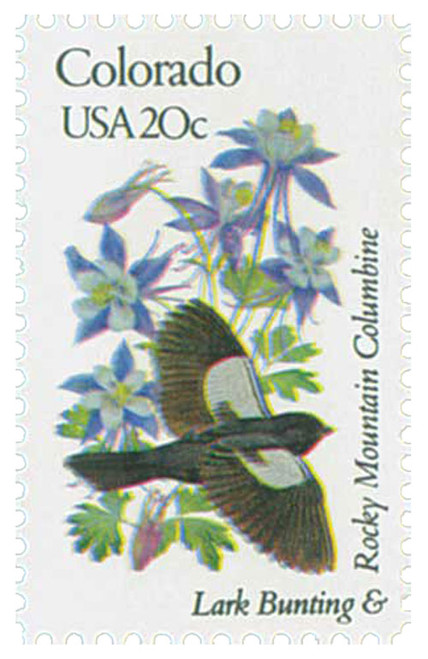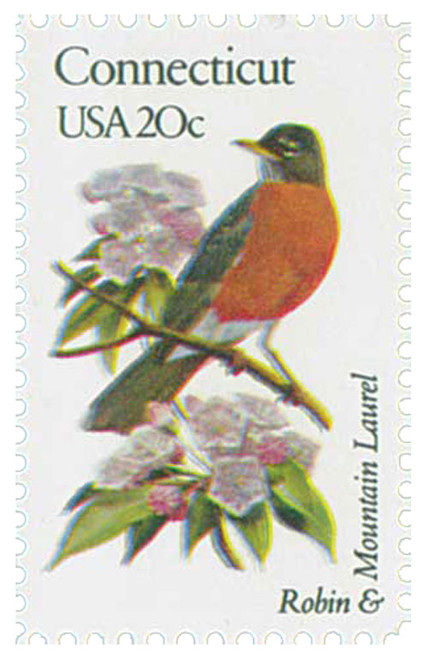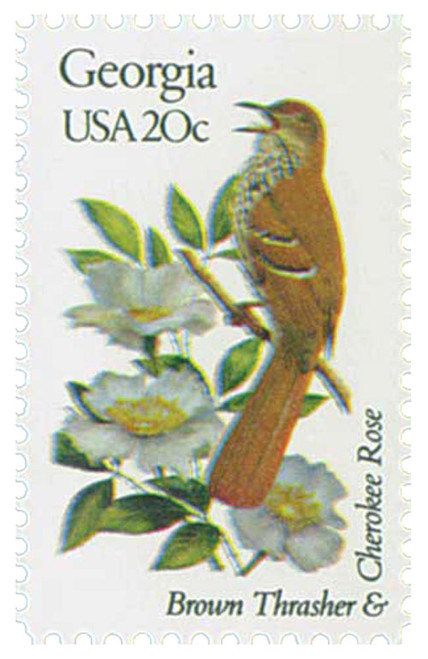
# 1981 - 1982 20c State Birds and Flowers: New Hampshire
20¢ New Hampshire
State Birds and Flowers
City: Washington, DC and state capitals
Quantity: 13,339,000 panes
Printed By: Bureau of Engraving and Printing
Printing Method: Photogravure
Perforations: 10.5 x 11.25
Color: Multicolored
New Hampshire Becomes 9th State
What is now New Hampshire was home to about 5,000 American Indians before European settlement. Most of these people belonged to the Algonquian Indian family. These Native Americans built houses called wigwams out of bark and animal skins. Hunting and fishing were supplemented by small-scale farming of corn. The Algonquian Indians often fought with their neighbors, the Iroquois.
It is unknown which European explorer first reached today’s New Hampshire. But, by the early 1600s, many expeditions had set foot on this land. In 1603, Martin Pring, an Englishman, sailed a trading ship up the Piscataqua River. Pring may have landed at the site of present-day Portsmouth. In 1605, the French explorer Samuel de Champlain landed on the New Hampshire coast. The English captain John Smith reached the Isles of Shoals in 1614.
King James I of England was very interested in settling the New England area. In 1619, he founded the Council for New England to organize and encourage settlers. The council gave David Thomson control of a large chunk of land in the New Hampshire area. Thomson settled in Odiorne’s Point, which is now part of Rye, in 1623. Edward Hilton established another settlement in the 1620s. Hilton’s group settled Hilton’s Point, which is now called Dover. Other early settlements include Stawbery Banke at the site of present day Portsmouth in 1630, and Exeter and Hampton in 1638.
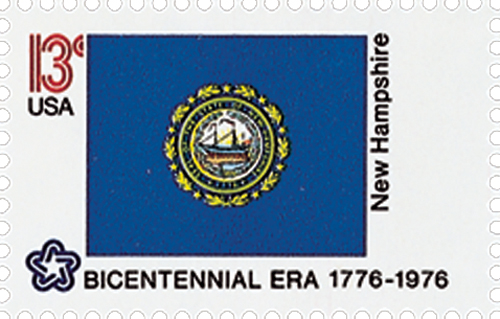
The Council for New England granted a large tract of land to John Mason and Sir Ferdinando Gorges in today’s Maine and New Hampshire. The land was divided between the two men in 1629. Mason called his land New Hampshire – he was originally from Hampshire, England.
New Hampshire was made part of the colony of Massachusetts in 1641, then King Charles II made it a separate province in 1680. The king named John Cutt as New Hampshire’s first provincial governor.
Between 1689 and 1763, the British and the French fought a series of four wars in North America. Both sides fought with the assistance of Indian allies. These two great Colonial powers fought for control of inland territories and for domination of the fur trade. As a result of the wars, the British gained control of most of France’s land in North America.
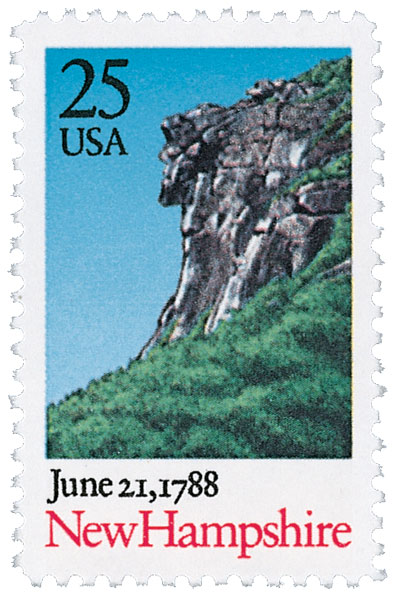
During the French and Indian wars, two Colonial leaders from New Hampshire earned great fame. Robert Rogers, the leader of a group of soldiers known as Roger’s Rangers, and John Stark both contributed to the British victory in this series of conflicts.
Colonial New Hampshire was very rural and had little industry. Most of the people were farmers who kept busy clearing land and raising food. When the colony took its first census in 1767, it was determined that 52,700 people made their homes there.
Although the king appointed New Hampshire’s governor and governor’s council, the people of New Hampshire enjoyed a great deal of independence. The people elected assemblymen who attended to Colonial affairs, and there was little interference from the crown. However, the taxation and trade laws passed by Great Britain during the 1760s upset the colonists.
The famous patriot leader Paul Revere rode to New Hampshire in December of 1774 to warn of an increase in British troops in the area. This prompted New Hampshire patriots under the leadership of John Sullivan to seize arms from a British military fort in New Castle. This raid was one of the first Colonial military actions against the British.
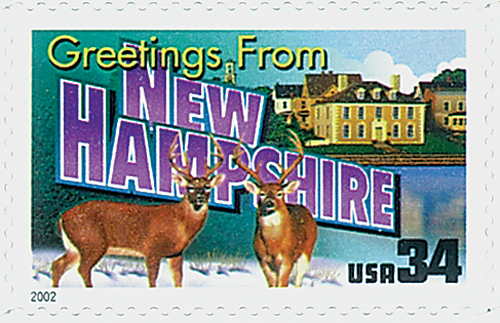
When the War for Independence broke out in Massachusetts in 1775, New Hampshire responded by sending hundreds of “minutemen.” New Hampshire’s soldiers served with distinction. Interestingly, New Hampshire was the only colony of the original 13 in which no actual fighting took place.
New Hampshire was the first colony to form its own independent government. On January 5, 1776, it adopted a temporary constitution. On June 21, 1788, New Hampshire became the ninth state to ratify the United States Constitution. New Hampshire’s approval of the document put the Constitution into effect and officially made it the United States of America’s ninth state.
After the American Revolution, life remained much the same in New Hampshire. The vast majority of people were engaged in agricultural pursuits. However, with the start of the American Civil War, a new industrial growth began. The state’s industrialization continues to this day.
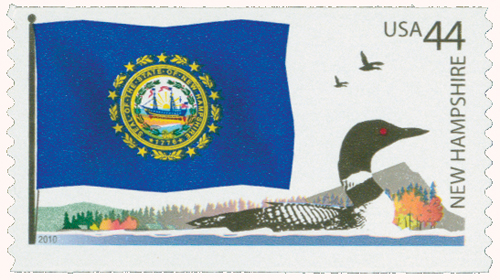
New Hampshire was well known as a leader in the anti-slavery movement. These beliefs were reflected in the fact that 34,000 of the state’s citizens served with Union forces. Portsmouth Naval Shipyard built many ships for the war effort. These ships were essential for the Union blockade of Southern ports.
After the war, industrial growth increased. Primary industries included textiles, woodworking, and leather. The new factories attracted thousands of immigrants from Canada and Europe. However, many of the state’s farmers left the state to claim free land in the West. Thus, the state’s agricultural output decreased while industries grew.
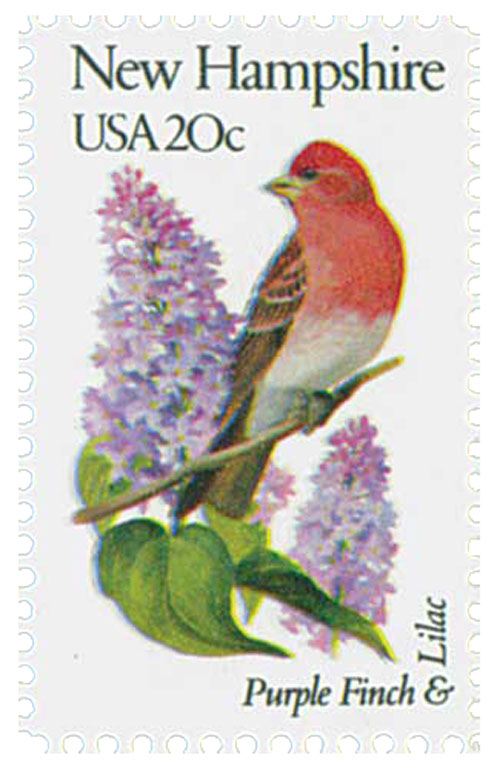
New Hampshire’s industries continued to grow throughout the 1900s. During World War I and World War II, Portsmouth built ships and other vessels needed by the U.S. Navy. The state’s textile mills made military uniforms. Other industries flourished as well. As a result, the state became increasingly urban.
20¢ New Hampshire
State Birds and Flowers
City: Washington, DC and state capitals
Quantity: 13,339,000 panes
Printed By: Bureau of Engraving and Printing
Printing Method: Photogravure
Perforations: 10.5 x 11.25
Color: Multicolored
New Hampshire Becomes 9th State
What is now New Hampshire was home to about 5,000 American Indians before European settlement. Most of these people belonged to the Algonquian Indian family. These Native Americans built houses called wigwams out of bark and animal skins. Hunting and fishing were supplemented by small-scale farming of corn. The Algonquian Indians often fought with their neighbors, the Iroquois.
It is unknown which European explorer first reached today’s New Hampshire. But, by the early 1600s, many expeditions had set foot on this land. In 1603, Martin Pring, an Englishman, sailed a trading ship up the Piscataqua River. Pring may have landed at the site of present-day Portsmouth. In 1605, the French explorer Samuel de Champlain landed on the New Hampshire coast. The English captain John Smith reached the Isles of Shoals in 1614.
King James I of England was very interested in settling the New England area. In 1619, he founded the Council for New England to organize and encourage settlers. The council gave David Thomson control of a large chunk of land in the New Hampshire area. Thomson settled in Odiorne’s Point, which is now part of Rye, in 1623. Edward Hilton established another settlement in the 1620s. Hilton’s group settled Hilton’s Point, which is now called Dover. Other early settlements include Stawbery Banke at the site of present day Portsmouth in 1630, and Exeter and Hampton in 1638.

The Council for New England granted a large tract of land to John Mason and Sir Ferdinando Gorges in today’s Maine and New Hampshire. The land was divided between the two men in 1629. Mason called his land New Hampshire – he was originally from Hampshire, England.
New Hampshire was made part of the colony of Massachusetts in 1641, then King Charles II made it a separate province in 1680. The king named John Cutt as New Hampshire’s first provincial governor.
Between 1689 and 1763, the British and the French fought a series of four wars in North America. Both sides fought with the assistance of Indian allies. These two great Colonial powers fought for control of inland territories and for domination of the fur trade. As a result of the wars, the British gained control of most of France’s land in North America.

During the French and Indian wars, two Colonial leaders from New Hampshire earned great fame. Robert Rogers, the leader of a group of soldiers known as Roger’s Rangers, and John Stark both contributed to the British victory in this series of conflicts.
Colonial New Hampshire was very rural and had little industry. Most of the people were farmers who kept busy clearing land and raising food. When the colony took its first census in 1767, it was determined that 52,700 people made their homes there.
Although the king appointed New Hampshire’s governor and governor’s council, the people of New Hampshire enjoyed a great deal of independence. The people elected assemblymen who attended to Colonial affairs, and there was little interference from the crown. However, the taxation and trade laws passed by Great Britain during the 1760s upset the colonists.
The famous patriot leader Paul Revere rode to New Hampshire in December of 1774 to warn of an increase in British troops in the area. This prompted New Hampshire patriots under the leadership of John Sullivan to seize arms from a British military fort in New Castle. This raid was one of the first Colonial military actions against the British.

When the War for Independence broke out in Massachusetts in 1775, New Hampshire responded by sending hundreds of “minutemen.” New Hampshire’s soldiers served with distinction. Interestingly, New Hampshire was the only colony of the original 13 in which no actual fighting took place.
New Hampshire was the first colony to form its own independent government. On January 5, 1776, it adopted a temporary constitution. On June 21, 1788, New Hampshire became the ninth state to ratify the United States Constitution. New Hampshire’s approval of the document put the Constitution into effect and officially made it the United States of America’s ninth state.
After the American Revolution, life remained much the same in New Hampshire. The vast majority of people were engaged in agricultural pursuits. However, with the start of the American Civil War, a new industrial growth began. The state’s industrialization continues to this day.

New Hampshire was well known as a leader in the anti-slavery movement. These beliefs were reflected in the fact that 34,000 of the state’s citizens served with Union forces. Portsmouth Naval Shipyard built many ships for the war effort. These ships were essential for the Union blockade of Southern ports.
After the war, industrial growth increased. Primary industries included textiles, woodworking, and leather. The new factories attracted thousands of immigrants from Canada and Europe. However, many of the state’s farmers left the state to claim free land in the West. Thus, the state’s agricultural output decreased while industries grew.

New Hampshire’s industries continued to grow throughout the 1900s. During World War I and World War II, Portsmouth built ships and other vessels needed by the U.S. Navy. The state’s textile mills made military uniforms. Other industries flourished as well. As a result, the state became increasingly urban.






